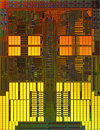Wednesday, January 14th 2009

AMD Justifies Use of Large L3 Cache on Phenom II, Opteron
AMD's introduction of the Phenom II series processors served several purposes and goals for the company, mainly porting the processor technology to the newer 45nm SOI manufacturing node, to attempt to bring down manufacturing cost. This also meant that AMD could trade-off bringing down manufacturing cost with stepping up transistor counts on a die that is nearly the size of that of the 65nm Barcelona/Agena. The 45nm Shanghai/Deneb has a distinct feature over its predecessor: three times the amount of L3 cache. The larger cache significantly adds to the transistor count of the die: 758 million as against the 468 million on Barcelona/Agena. Replying to an inquiry of Hardware-Infos, AMD attempts to explain its motive behind incorporating the large L3 cache, while trading-off with savings of die-size and alleged latencies the L3 cache brings in.
AMD points out that expanding the L3 cache was important to the architecture in more ways than one. On the desktop/client PC front, the additional L3 cache was expected to provide a 5% performance increment over its predecessor. The reviews later backed AMD's assertion. Secondly, AMD likes to maintain an essentially common die design for both its client (Phenom II/Deneb) and enterprise or server (Opteron/Shanghai), to make sure manufacturing costs aren't wasted in setting up a separate manufacturing node. With the enterprise-grade Opteron processors, the 6 MB L3 cache has proven to benefit the processor in dealing with large server workloads. Finally, AMD claims that despite the larger cache, the overall die-area of the 45nm die remains lesser than that of the 65nm Stars die, so cost-cutting remains to an extant.
Source:
Hardware-Infos
AMD points out that expanding the L3 cache was important to the architecture in more ways than one. On the desktop/client PC front, the additional L3 cache was expected to provide a 5% performance increment over its predecessor. The reviews later backed AMD's assertion. Secondly, AMD likes to maintain an essentially common die design for both its client (Phenom II/Deneb) and enterprise or server (Opteron/Shanghai), to make sure manufacturing costs aren't wasted in setting up a separate manufacturing node. With the enterprise-grade Opteron processors, the 6 MB L3 cache has proven to benefit the processor in dealing with large server workloads. Finally, AMD claims that despite the larger cache, the overall die-area of the 45nm die remains lesser than that of the 65nm Stars die, so cost-cutting remains to an extant.

28 Comments on AMD Justifies Use of Large L3 Cache on Phenom II, Opteron
Kei
With HT or QPI there is no need for large caches, however there are always some exceptions.
L3 is beneficial only when it has faster access than the system RAM.
The main problem with L3 is that it takes up a lot of real estate and therefore it costs a lot.
AMD and Intel both are moving in the same direction here (to add L3). Why? I think it is because of the direction system memory is moving. Yes, DDR2 has more bandwidth than DDR and DDR3 has more bandwidth than DDRw but at what cost? Latency. DDR3 is a friggin snail compared to DDR when it comes to latency. The only way to address that is to add a middle man to compensate for the huge gap between L2 and DDR3, that is, to add an L3. If DDR3 was actually fast, L3 would be useless.
So effectively, we pay more (relatively speaking) for a lower latency processor and less for higher latency memory. Is that a good thing? I don't know.
may be this is why AMD made the L3 bigger since its moving to DDR3? But then again i was reading somewhere that the smaller 2MB L3 cache was hurting Phenom 1.
But if they did, "It improve performance" is all they need to say.
If only all AMD had to compete against was some ghetto P4-based quad core. We'd all be singing the virtues of AMD's amazingly advanced ultra-fast quad. ;)
Everyone just wants high MHz for marketing and as everyone with any know-how knows, it doesn't mean shit.
BTW i gotta Ask KBD whats your Socket A rig consist of, you see mine in the system specs as that is my main machine.
I'm actually looking for a SATA board for that rig, if i ever find like yours i'd be very happy, afterall thats the best Socket A board ever.
But ya, this machine is somewhat limited due to no cooling for Mosfet/VRMs, and the NB and SB cooling is pretty dismal aswell (Chipset runs hotter than CPU) so all that stuff needs upgrades. I had a 3200+ in this machine and i crushed it accidently (never modifiy the clip on a CPU cooler by bending it to put more tension on the CPU) So i picked up 2 2500+ CPUs (Mobility and Desktop). Both do 3200+ easily so thats where i run the current, just want to get all the cooling upgrades and Possibly overclock this CPU to at least 2.5, as these CPUs like 1.7-2.0 Vcore. Above all, COD4 is a good test of a Machines stability, and 2.2Ghz runs that game excellent with the vidcard i have.
That's prime stable and I didn't attempt to push it further.
I love the skt As b/c of the pin mods. You can overclock no matter what the MB is, practically (but I just upped this FSB on this one, ocing the ram also).